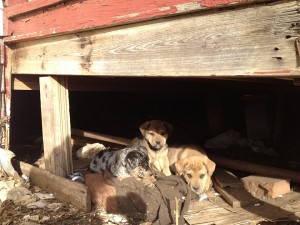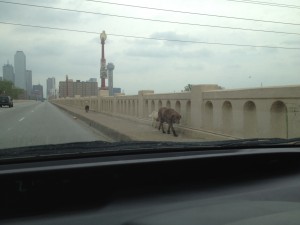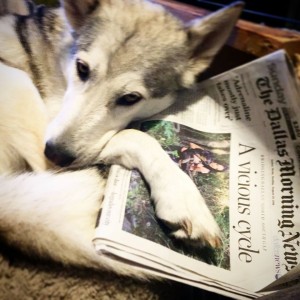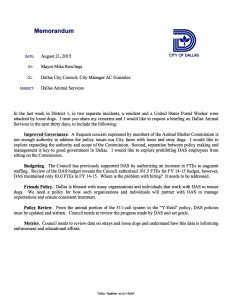First, yes, we know this is a long-ish document. It’s a complicated problem, but the good news is that we have condensed years of conversation into just a few pages. Please read it all to help understand the issues from a user’s and tax payer’s perspective.
Animal issues are the number one complaint heard by city council members across the city. Loose animals, aggressive animals, dumped animals, unvaccinated and unneutered animals are all part of the challenges facing our city. These issues are often associated with high crime rates and quality of life issues and they make our neighborhoods, schools, tourist areas, and targeted areas of economic development unsafe.
This crisis level issue has received both national attention and coverage from all the local media outlets (we’ve collected some of the press here), including a recent Dallas Morning News expose which included: front page of the Sunday paper with content above and below the fold with a huge color photo; a double-page spread inside with eight photos, the graphic with Scott Griggs’ memo to the Mayor; yet a third inside page with another photo and graphic and another sidebar on how suburban shelters are dealing with the problem; PLUS the entire editorial space in the Points section, with “four things that would go a long way toward fixing” the problem, along with contact information for the mayor and all council members. This is massive! Add to the print edition all the online coverage, with the slide shows, a heart wrenching video, interactive map and, of course, Sharon Grigsby’s blog posts that started it all
In recent years, Dallas Animal Services (DAS) has made a conscious shift away from animal control and enforcement. This shift disregarded the requests and orders of Council as well as the will of the taxpayers and voters. This shift in policy has led us to today, where loose animals are a crisis level safety and quality of life issue in our southern sector neighborhoods and this problem is creating unhappy citizen who are ready to move out of the city to get away from their unsafe neglected neighborhoods. The issue is not only driving people away, it is blocking investment and the success of the Mayor’s Grow South initiative.

These third generation street puppies were born under a house that was for sale. The momma dog would not let investors and realtors on the property.
After a full spread in the Dallas Morning News, we should not waste another minute debating whether or not there is a problem (Check the Dallas Morning News’ 311 interactive loose animal map) or if the problem will spread to other areas in the city…it will (see the Dallas Morning News article about animals issues in City’s that border Dallas).
Crisis level animal issues have been on the agenda in District 1 for several years. After several years of high levels discussions with DAS about animal issues in his district and three recent separate dog attacks in District 1 in a week, District 1 Councilman Scott Griggs was compelled to send a memo to the Mayor asking for a the full council to receive a briefing on the DAS budget and their plan to address the crisis level issues. The memo included concerns some regarding: improved governance, budgeting, a friends policy, policy and procedure review, and metrics.
He is essentially telling The Mayor and the Council that there are ethical issues with the head of DAS being on an advisor board designed to advise the head of DAS. He wants to remove conflicts of interest and give the Animal Commission the power to serve and support the needs of the people.
He is kindly asking that the city look into why when the City gave DAS the money and headcount for a large number of staff, DAS did not hire the staff. To add insult to injury, DAS continued to tell the public they didn’t have enough budget or people to address our loose animal issues. The council will look into if DAS is mismanaging their money and not doing what is requested of them by Council and the citizens. Griggs is asking for answers and accountability.
Councilman Griggs is recommending to the Mayor that things would go a lot smoother if DAS would work out a policy and procedure to work with active communities like ours to help address the animal issues.
He continues to then point out that the policy and procedures need to be re-written and reviewed and that council needs to help set their goals and hold DAS accountable to their goals.
The last most fabulous point is that he is recommending the council needs to review data on loose dogs so it can inform enforcement and educational initiatives and the budget needed to enact those efforts.
What a powerful memo. As the City Council hears a briefing from DAS, it is also important for citizens to help City leadership fully understand the identified and documented issues and to help them to be accountable to a plan that solves our animal issues in both the short and long term.
Here’s where the people’s voice is important: what will the City’s goals be ? What will our measure of success be across each step along the way? What are we trying to accomplish for our neighborhoods, our residents, and our City’s overall reputation
Business plan 101 / Budget
In order to address animal issues across Dallas, the city must examine the needs and the roadblocks. Funding and staffing are always the first lines of defense against any criticism of the current failing system. In order to understand what is the proper level of funding, DAS must have measurable goals and a short and long term business plan which includes a high level focus on animal control.
Agreed upon goals and metrics are important. As every business owner knows, you only improve what you measure. Let’s make sure everyone is aligned and accountable to what the citizens ask of the City and their leaders. Hiring more officers will not ensure the problems will be addressed. Headcount and budget are not the real issues.
Take the opportunity to restructure and modernize
Perhaps from years of making due with a reduced budget, Dallas Animal Services’ policies and best practices have fallen behind. Countless dogs slip through the cracks via mistakes, miscommunication, poor training, and confusion around DAS policy everyday. Too long animal issues have been dismissed and neglected by the City and now citizens are paying the price with “blood and bone”.
“The best you can do with what you have” is no longer good enough. Our city and its residents are suffering harm and they deserve better. Today we stand at a cross roads as we face this crisis level issue, let’s not just ask our City leaders to raise the bar, let’s ask our world class City to be an industry leader as we search for solutions to this systemic problem.
Embrace Change
In order for DAS to address the known problems and to realize full success with the citizens they serve, they must reorganize and revamp their best practices to reflect modern behaviorally sound SOPs, roll out a Field Services model that uses behaviorally sound practices to catch loose animals, and they need to embrace and adopt a community service model of prevention, intervention, and enforcement to achieve their short and long term goals. Without this systemic change and evaluation, animal issues and the safety of our communities cannot be fully addressed.
Current best practices and training
Lack of appropriate training endangers employees, citizens, and animals on a daily basis. Current best practices and training are so ineffective and insufficient tragic mistakes are made everyday. Mistakes in life and death temperament assessments, mistakes in simple tasks like documenting people’s contact information, mistakes in contacting a chipped pet’s owners, in adoption practices, and even mistakes that leave dangerous dogs on our streets. There is plenty of documentation to support these cracks and weakness in the foundation of the organization. Let’s rebuild a new framework to hold up the organization and give them the tools to allow them to succeed.
Use the Public Information Office (PIO)
What does Dallas Animal Services stand for? Kill? No-Kill? Catch and Kill? Working through the PIO allows the marketing and message house to be consistent with the City’s objectives, brand, and goals. This ensures a consistent City approved message house that aligns City Council, DAS, the Animal Shelter Commission, and DCAP; currently, their goals and message house are not aligned (see the HSUS 2010 report – section 9).
This oversight will also ensure that the messaging will come from a trained, experienced marketing professional. Social media is an increasingly important vehicle to elevate the City’s brand and create a crafted impression the City wants to leave on citizens, visitors, and international business and events. Official websites and Facebook pages are branding tools, let the DAS and other city websites and Facebook pages reside under the PIO.
Most importantly, the PIO can help align department like 311, 911, Parks and Rec, Code, and Animal Services under one umbrella of a “culture of clean”. One consistent voice and message house from the City regarding policy, prevention, intervention, and enforcement will be important to changing the animal culture in our city and for our City’s growth. From Mayor Mike Rawlings, ““To attract business capital, you’ve got to be clean…you have to look good… the issue of loose dogs is bedeviling efforts to revitalize southern Dallas.”
Measure need, goals, accountability, and success
Let’s get on the same page! Currently voters, taxpayers and council want loose dogs picked up. DAS does not think picking up loose dogs is worth the return on investment. DAS currently measure of success is live release rates. The citizens’ safety and quality of life is not currently measured, nor is it a measure of success. Advocate for DAS and DCAP to move from a culture where lowering euthanasia rates is the top measure of success to a more balanced approach where safety and quality of life and working towards a city wide spay and neuter culture are measured indicators of success. Lower euthanasia rates will be a result of that long term strategic plan, but live release should not the top priority; that priority and viewpoint is counterproductive to solving the problems at hand.
From Mayor Mike Rawlings, “ When there are loose dogs in the street,” Rawlings said, “we need to come out and get them.”
From the independent 2010 HSUS report (section 9.1):“…there was obvious dichotomy between the City Council’s goals and the goals of the Animal Shelter Commission as well as the animal welfare community. The latter two placed a high priority on moving the community toward lower euthanasia rates. On the other hand, The City Council established a goal to increase impoundment—the FY09‐10 City Council objective to impound 37,713 animals represented an 85% increase over FY08‐09. …This disparity in goals was fueling a continuing conflict between the City Council, DCCS leadership, DAS management and staff, the Animal Shelter Commission, the nonprofit animal welfare community, and the public.”
Policy and Procedure
Conflicting information and incorrect policy is constantly being given out to the public. Regardless of being shorthanded or understaffed, all DAS staff should be competent and understand policy, including management. If the challenges of training temp employees is too difficult, then an overhaul of the staffing and hiring process should be considered.
If DAS and City management doesn’t have time to set a vision and address the citizen’s issues in a timely manner, bring in a consultant who can. Dallas Animal Services’ negative reputation can be attributed to a regular stream of misinformation about policy and procedure. As the press has shown us, this negative reality sticks to the City’s brand as well, at a national and international level.
It’s not just about budget and staffing.
Here are some broad strokes IDEAS from a users perspective that will allow the City to meet the goal of safer neighborhoods and an improved safety and quality of life for our neighbors and our city’s animals.
Budget and auditing
- Advocate for a DAS budget to be in line with similarly sized cities. Dallas is the 9th largest city in the US. North Texas is one of the fastest growing areas in the country. Dallas Animal Services’ budget is currently not growing at a pace that keeps up with the needs and basic safety expectations of the citizens.
- Conduct an independent financial audit of DAS and DCAP to understand where and how the money is currently being spent
- Create a more detailed line item budget (as recommended in the 2010 Humane Society Audit) (see the HSUS 2010 report – section 10).
- Budget for an audit: Conduct a new Human Society of the United States audit to understand gaps in best practices, to identify areas needing improvement, and to understand the path to reaching the City’s goal.
- Create a vehicle to plan and achieve the recommendations in the final audit.
- Budget for an initiative to improve best practices and training.
- Budget to write new policy and procedures and to train and roll out the new policy and procedures.
Field Services polices are ineffective, behaviorally unsound, and at times inhumane
- In order to fix the loose animal issues, Field Service must become a high priority. This is the “dog catcher” arm of the animal control.
- Determine what percent of the budget should go to animal control, enforcement, education initiatives, time in court, etc and create a line item budget that will allow DAS to achieve short and long term goals.
- DAS field services must adopt modern behaviorally sound best practices for their field services SOPs.
- Recognize documented issues with:
- Ineffective practices are endangering the public
- Ineffective practices and behaviorally unsound approaches are compounding the hard to catch dog problem and are at times inhumane, neglectful, and or injurious to the animals.
- Tax payer dollars are being wasted due to ineffective and inefficient practices
- Efforts are poorly coordinated with little or no communication between 911, 311, DAS, and the residents.
The Shelter
- Adoption councilors, intake councilors, consulting behaviorist should all be part of the shelter’s best practices. Industry studies are available to help understand the return on investment and value of these positions.
- All employees should have animal handling and behavior training
- Audit shelter practices with another HSUS independent audit.
- Create a vehicle to execute the HSUS recommendations
- Measure the goals and success of this plan
- Hold leadership accountable for implementing this plan
Community Outreach
- Commission members should live in their district and be a point of contact for the needs of the neighborhoods.
- Create of a staff position for an “Animal Services Neighborhood Liaison” in each sector of the City (follow DPD model)
- Advocate for the City of Dallas and Dallas Animal Services to understand the value of a collaborative volunteer workforce. Following the Police Department model where 80% of time is dedicated to intervention and prevention and the last 20% of time is dedicated to enforcement requires budget for community level involvement, education, and organization.
- Advocate for your Neighborhood Association to include animal issues in quality of life and safety discussions
- Advocate for your Crime Watch Committees to include animal issues in quality of life and safety discussion.
- Advocate for your National Night Out to include animal safety information and spay, neuter, and low cost vaccination resource information
A Balanced Approach
“Catch and Kill” vs “no kill” vs “community outreach” are not exclusive to each other. Community Outreach is a long term strategic plan, and we agree with it as outlined in the Oak Cliff Animal Initiative which references the Police Departments 80/20 model. Additionally, community outreach will only work with parallel effort for animal control and compliance.
To make our streets safer tomorrow, a short term high focus on animal CONTROL is needed and FAST! If DAS pursues a heavy community outreach without sufficient low or no cost resources, without an ability to enforce violations through ticketing and the courts, and with compliance checks, nothing will change and the trend of residents being attacked and bitten weekly will continue.
Additionally, DAS’ current budget for “Community Outreach” does not have line items for expenses necessary for community outreach collateral. Things like flyers, hand outs, spay and neuter resources, etc. that will make the program successful over time are not currently budged. We know this is very important to community conversations and lack of collatoral has been a roadblock in the past.
Rules of engagement
- Let’s acknowledge that the system is broken
- Identify the Issues. We need to identify issues to solve them. Active listening, not reactionary listening intended to defend, will yield the best results.
- Say it with a smile and with respect. We are all here to collaborate to solve problems, but tax payers deserve to be heard and the problems acknowledged. Tax payers that are advocating for change are not the problem, receive their feedback with an open mind and a smile.
- Agree to disagree. Healthy safe conflict always yields the best solutions. We may not all agree when openly discussing the issues, but we should respect each other’s positions.
- Euthanasia – Tough choices are part of the converstation: humane euthanasia or death by street life. To help facilitate meaningful conversation, stop using inflammatory language when discussing picking up loose animals.
- We’re for DAS. Asking for change and evaluation does not mean that the citizens are not for DAS. Tax payers need DAS to serve the needs of the entire City, not just the affluent parts. When DAS succeeds, we all succeed.
Animal Laws
- Advocate for regular meeting and reviews between prosecutors, animal services officers, officers of the law, and lawmakers to make sure the laws are effective and the intent of the law can be honored and prosecuted.
Next steps
Now that you have made it through the Readers Digest, we suggest anyone who wants to be part of the conversation or part of the solution read the independent shelter review conducted by the Humane Society of the United States. They are known experts and industry leaders. The report is a road map to success.
Also, revisit the Oak Cliff Animal Initiative meeting notes and roadmap from 2014 and 2015. They provide more details about the DPD model and the issues with the current system.
Be sure to read the DMN articles and comment in the comment section at the bottom of the page. The City watches the comments on the DMN page.
Thank you for caring about our City, our neighborhoods, and our safety and quality of life for both the residents and the tax payers. Together, we will make our City a safer, better place to live.
To make your views known on the abandoned and stray dog problem, contact the mayor and your council representative. (Don’t know which district you are in? Go to bit.ly/DallasDistricts to find a map.)
Mayor Mike Rawlings … 214.670.3301
mike.rawlings@dallascityhall.com
Scott Griggs, District 1 … 214.670.0776
scott.griggs@dallascityhall.com
Adam Medrano, District 2 … 214.670.4048
adam.medrano@dallascityhall.com
Casey Thomas, District 3 … 214.670.0777
casey.thomas@dallascityhall.com
Carolyn King Arnold, District 4 … 214.670.0781
carolyn.kingarnold@dallascityhall.com
Rickey Callahan, District 5 … 214.670.4052
rick.callahan@dallascityhall.com
Monica Alonzo, District 6… 214.670.4199
monica.alonzo@dallascityhall.com
Tiffinni Young, District 7… 214.670.4689
tiffinni.young@dallascityhall.com
Erik Wilson, District 8 … 214.670.4066
erik.wilson@dallascityhall.com
Mark Clayton, District 9 … 214.670.4069
mark.clayton@dallascityhall.com
Adam McGough, District 10 … 214.670.4068
adam.mcgough@dallascityhall.com
Lee Kleinman, District 11 … 214.670.7817
lee.kleinman@dallascityhall.com
Sandy Greyson, District 12 … 214.670.4067
sandy.greyson@dallascityhall.com
Jennifer Gates, District 13 … 214.670.3816
jennifer.gates@dallascityhall.com
Philip Kingston, District 14 … 214.670.5415









